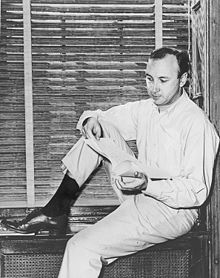Neil Simon
After graduating from high school and serving a few years in the Army Air Force Reserve, he began writing comedy scripts for radio programs and popular early television shows.
[5]: 378 I think part of what made me a comedy writer is the blocking out of some of the really ugly, painful things in my childhood and covering it up with a humorous attitude ... do something to laugh until I was able to forget what was hurting.
Simon acknowledged these childhood films as his inspiration: "I wanted to make a whole audience fall onto the floor, writhing and laughing so hard that some of them pass out.
"[5]: 379 He began writing for pay while still in high school: At the age of fifteen, Simon and his brother created a series of comedy sketches for employees at an annual department store event.
To help develop his writing skill, he often spent three days a week at the library reading books by famous humorists such as Mark Twain, Robert Benchley, George S. Kaufman and S. J.
"[13]: 3 Barefoot in the Park (1963) and The Odd Couple (1965), for which he won a Tony Award, brought him national celebrity, and he was considered "the hottest new playwright on Broadway", according to Susan Koprince.
During 1966, Simon had four shows playing simultaneously at Broadway theatres: Sweet Charity,[14] The Star-Spangled Girl,[15] The Odd Couple[16] and Barefoot in the Park.
[18] His professional association with producer Emanuel Azenberg began with The Sunshine Boys and continued with The Good Doctor, God's Favorite, Chapter Two, They're Playing Our Song, I Ought to Be in Pictures, Brighton Beach Memoirs, Biloxi Blues, Broadway Bound, Jake's Women, The Goodbye Girl and Laughter on the 23rd Floor, among others.
By the time of Last of the Red Hot Lovers in 1969, Simon was reputedly earning $45,000 a week from his shows (excluding sale of rights), making him the most financially successful Broadway writer ever.
[18] Simon also served as an uncredited "script doctor", helping to hone the books of Broadway-bound plays or musicals under development,[21] as he did for A Chorus Line (1975).
Although he was, by then, recognized as one of the country's leading playwrights, his inner drive kept him writing: Did I relax and watch my boyhood ambitions being fulfilled before my eyes?
In 1983, he began writing the first of three autobiographical plays, Brighton Beach Memoirs (1983), which would be followed by Biloxi Blues (1985) and Broadway Bound (1986).
Simon wrote screenplays for more than twenty films and received four Academy Award nominations—for The Odd Couple (1969), The Sunshine Boys (1975), The Goodbye Girl (1977) and California Suite (1978).
[1]: 153 The Odd Couple (1968), was one highly successful early adaptation, faithful to the stage play but also opened out, with more scenic variety.
[26] The key aspect most consistent in Simon's writing style is comedy, situational and verbal, and presents serious subjects in a way that makes audiences "laugh to avoid weeping".
[6]: 139 This creates a "sophisticated, urban humor", says editor Kimball King, and results in plays that represent "middle America".
[3]: 1 Simon created everyday, apparently simple conflicts with his stories, which became comical premises for problems which needed be solved.
In The Gingerbread Lady, he combined comedy with tragedy; Rumors (1988) is a full-length farce; in Jake's Women and Brighton Beach Memoirs he used dramatic narration; in The Good Doctor, he created a "pastiche of sketches" around various stories by Chekhov; and Fools (1981), was written as a fairy-tale romance similar to stories by Sholem Aleichem.
[1]: 150 Although some of these efforts failed to win approval from many critics, Koprince claims that they nonetheless demonstrate Simon's "seriousness as a playwright and his interest in breaking new ground.
[13]: 10 McGovern notes that his characters are always impatient "with phoniness, with shallowness, with amorality", adding that they sometimes express "implicit and explicit criticism of modern urban life with its stress, its vacuity, and its materialism.
"[6]: 141 Theater critic John Lahr believes that Simon's primary theme is "the silent majority", many of whom are "frustrated, edgy, and insecure".
Within that setting, Simon's themes include marital conflict, infidelity, sibling rivalry, adolescence, bereavement and fear of aging.
"[1]: 14 His comedies often portray struggles with marital difficulties or fading love, sometimes leading to separation, divorce and child custody issues.
"[1]: 9 Drama critic Richard Eder noted that Simon's popularity relies on his ability to portray a "painful comedy", where characters say and do funny things in extreme contrast to the unhappiness they are feeling.
For example, in the Brighton Beach trilogy, she explains, the lead character is a "master of self-deprecating humor, cleverly poking fun at himself and at his Jewish culture as a whole.
"[1]: 9 During most of his career, Simon's work received mixed reviews, with many critics admiring his comedy skills, much of it a blend of "humor and pathos".
As a result, notes Kopince, "literary scholars had generally ignored Simon's early work, regarding him as a commercially successful playwright rather than a serious dramatist.
"[1]: 4 Clive Barnes, theater critic for The New York Times, wrote that like his British counterpart Noël Coward, Simon was "destined to spend most of his career underestimated", but nonetheless very "popular".
She concludes, "It is my firm conviction that Neil Simon should be considered a member of this company ... an invitation long overdue.
[13]: 192 Similarly, literary critic Robert Johnson explains that Simon's plays have given us a "rich variety of entertaining, memorable characters" who portray the human experience, often with serious themes.

